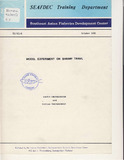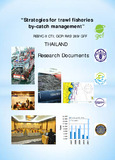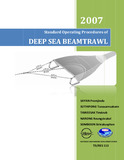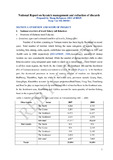Model Experiment on Shrimp Trawl
Abstract
Trawls are recognized as a fishing gear that has a high catching efficiency and plays an important role in the fisheries of the world. However, trawls are also seen as a type of gear that accelerates the destruction of natural resources.
A shrimp trawl that is designed primarily to catch shrimp. However, the shrimp trawl catch not only shrimp but also small fish, juveniles and other marine animals. Approximately 70 percent of the catch of a shrimp trawl consists of trash fish . It should be not that the so-called fish include juveniles and fry of several economically important species.
It appears that trash fish are an unwanted catch for shrimp trawlers because of the low return. The shrimp will be picked out from the catch and the rest will sometimes be thrown back. It is a mistake to ignore the effects this practice will have on the natural resources, particularly since some of these fish would become profitable if fishermen only waited to catch them when they are of adult size.
A trawl net with a window is one of the devices to catch only shrimp and thus avoid the destruction of natural resources by allowing small fish or juveniles to escape. This device has been adopted in many parts of the world.
An experiment was carried out to establish the effect of the window in a full-scale net. For the compete experiment, a model was used because of the difficulty of studying the physical aspects underwater in a full-scale experiment.
The model experiment was carried out with two purposes:
1. To study the resistance of net and height of net month as affected by the window of the net; and
2. To compare the resistance of net and height of net mouth of two-seam and four-seam nets.
This paper presents the results of the model experiment on shrimp trawl and the method used, for those who are interested in the operation of this gear. It also describes how to make a model net.
Subject
Collections
Related items
Showing items related by title, author, creator and subject.
-
Gulf of Thailand Trawl Experiments Using 4.0 cm Codend Mesh
Phoonsawat, Ratanawalee; Auksonphaob, Udomsin; Cheuamankong, Thitipon; Panjarat, Sampan (Training Department, Southeast Asian Fisheries Development Center, 2016-09)In responce to the depletion of fisheries resources in the Gulf of Thailand, the DOF Thailand, in collaboration with the Food and Agriculture Organization of the United Nations (FAO) and Southeast Asian Fishery Development ... -
Standard Operating Procedures of Deep Sea Beamtrawl
Promjinda, Sayan; Tanasornsakorn, Suthipong; Timkrub, Taweesak; Reungsivakul, Narong; Siriraksophon, Somboon (Training Department, Southeast Asian Fisheries Development Center, 2007)Beam Trawl net is a type of bottom trawl net. The target catches of beam trawl is coastal shrimp. The beam trawl fishing has been recorded of the operation in Thailand since 1957. It is the prototype of the other bottom ... -
National Report on Bycatch Management and Reduction of Discards
Thong, BaNguyen; Dang, Van Thi (2009)National consultants are invited from fisheries research institutes and working under the contracts signed with project manager/project in charge organism. The appropriate candidates basically will work on short time period ...




